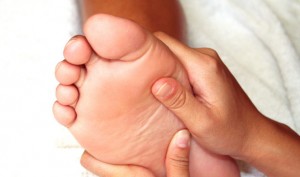By Dr. Daniel Pero –
 Apodiatrist is a physician who specializes in medicine and surgery of the foot and ankle. It is a specialty that is often misunderstood. Many question their scope of practice, capability, the length/type of education and training required, and their abilities in treating patients. In this issue we will try to explain the podiatrist’s role and shed some light on the profession, as well as clear up some “myths” about podiatry and the treatment of feet in general.
Apodiatrist is a physician who specializes in medicine and surgery of the foot and ankle. It is a specialty that is often misunderstood. Many question their scope of practice, capability, the length/type of education and training required, and their abilities in treating patients. In this issue we will try to explain the podiatrist’s role and shed some light on the profession, as well as clear up some “myths” about podiatry and the treatment of feet in general.
Today’s podiatrist typically completes a Bachelor’s Degree or equivalent from an undergraduate college or university. Then they matriculate into one of several specialized medical schools that focuses not just on feet, but also on general medical studies for the first two years, often alongside other students enrolled in MD or DO programs. The following two years of medical school focuses on medicine and surgery of the foot, ankle, and lower leg. During these years, students complete a series of month-long externship rotations at hospitals and physician offices, gaining additional training and experience. Nationwide student board exams are completed during these years as well. Upon completion of podiatric medical school, graduates earn a degree of Doctorate in Podiatric Medicine, or a “DPM” degree.
Today, podiatry graduates typically attend a 3-year foot and ankle surgical residency after podiatry school, with multiple rotations in other specialties, including orthopedic, general, vascular, and plastic surgery, as well as, dermatology, rheumatology, radiology, internal medicine, family practice, neurology, pathology, and behavioral medicine. During these rotations, resident podiatrists are trained to performing complete history and physical exams, order diagnostic tests, prescribe medications, perform surgery, and treat patients in hospitals, clinics, and offices alongside other DPM, MD, and DO residents in varying specialties. Again, nationwide examinations are held to establish residents as Board Eligible or Board Qualified. After residency, podiatric physicians generally require up to 7 years to become Board Certified.
Historically, podiatrists have had differing amounts of training. Basically, the number of years of residency completed and the amount of surgery performed during these years has increased over time. This may be why the profession is a bit misunderstood, where one podiatrist may not perform surgery, another in the same area may perform total ankle replacement surgery. A movement to bring uniformity to length and focus of residency training of podiatric physicians is in place, which may help alleviate any ambiguity among the profession.
Furthering confusion, each state determines the scope of Podiatry practice in relation to foot, ankle, and the lower leg. In Florida, podiatric physicians’ scope of practice includes surgical procedures involving bones below the knee joint, and non-surgical treatments of soft tissue structures that are below the hip joint, that insert into the foot, such as skin and tendons.
Many podiatric physicians perform general podiatry, where some may sub-specialize in dermatology, geriatrics, diabetic foot care, wound care, sports medicine, biomechanics, trauma, and orthopedic surgery. Most practice as solo practitioners or in small group practices, larger multi-specialty group practices, orthopedic group practices, and some are employed by hospitals. Several DPM’s also hold faculty positions at allopathic, osteopathic, and podiatric medical schools.
Today’s podiatrist diagnose and treat a wide variety of conditions, employ a multitude of surgical and non-surgical treatment modalities, and play a key role in foot health, which is imperative for the complete healthcare of an individual. They treat patients of all ages, from infants to seniors. They are essential for the comprehensive and preventive care for many people who suffer from diabetes, neuropathy, and peripheral vascular disease, and save our country millions of dollars in healthcare each year for this reason. To the right is a list of the more commons conditions seen and treatments performed:
- arthritis
- blisters
- bunions
- calluses
- deformities
- dermatitis
- diabetes-related conditions
- dry skin
- eczema
- flat feet
- foot and ankle fractures
- foot odor
- fungal infections
- gout
- hammertoes
- heel pain
- heel spurs
- high-arch feet
- hyperhidrosis
- infections
- ingrown toenails
- injuries
- laser therapy
- metatarsalgia
- nail disorders
- neuritis
- neuromas
- neuropathy
- obesity-related injuries
- osteoarthritis
- osteoporosis-induced fractures
- pain
- plantar fasciitis
- psoriatic arthritis
- rheumatoid arthritis
- skin cancer
- skin diseases
- skin disorders
- sprains / strains
- spider veins
- stress fractures
- foot and ankle trauma
- tendonitis
- toenail fungus
- tumors
- ulcers
- varicose veins
- vascular insufficiency
- vascular disease
- warts
- wounds
If you suffer from any of these, podiatrists are highly trained physicians and surgeons that are dedicated to helping you. For more information please visit the American Podiatric Medical Association (APMA) at www.apma.org or the American College of Foot and Ankle Surgeons (ACFAS) at www.acfas.org.
Integrative Foot & Ankle
(561) 293-3439
 South Florida Health and Wellness Magazine Health and Wellness Articles
South Florida Health and Wellness Magazine Health and Wellness Articles




